- Thousands of monks and laypeople across Tibet have been roped into participating in a series of major staged performances symbolic of the Communist Party’s control over their lives as Chinese authorities mark the 70th anniversary of the People’s Republic of China (PRC) on Oct. 1, known as National Day. The celebrations focused on “telling the story of the Communists” and erasing the stories of the Tibetans.
- In the eastern Tibetan region of Chamdo (Chinese: Changdu), large groups of monks participated in a rousing chorus in an old-fashioned, choreographed propaganda video that involved displaying giant images of China’s leader Xi Jinping.
- The hyped-up political messaging and scale of this week’s anniversary events seem intended to demonstrate and underline the loyalty of leaders and officials in Tibetan areas to the Chinese Communist Party (CCP) leadership. Communist forces invaded Tibet shortly after establishing the PRC in 1949 and fully annexed the historically independent country ten years later.
Political message strikes at heart of Tibetan faith
On Sunday, Sept. 29, more than 4,000 people were marshaled outside the Potala Palace in Tibet’s Capital of Lhasa for the official event marking the 70th anniversary of the founding of the People’s Republic of China. Women wore traditional Tibetan dress adorned with red sashes emblazoned with Communist Party slogans and with red hearts painted on their faces. Communist Party slogans and Chinese flags were everywhere—and in a particularly disturbing placement that shocked even Tibetans familiar with Beijing’s excesses, a banner advocating that the Communist Party should prosper for 10,000 years was hung above the entrance of the Jokhang Temple, the religious and cultural heart of Lhasa and one of Buddhism’s most sacred sites.
Even the international five-star hotel, the InterContinental Lhasa Paradise, participated in the commemoration. Images on state television depicted hundreds of people gathered in front of the luxury hotel forming the shape of a heart depicting love for the CCP along with an anniversary display on the hotel’s facade.
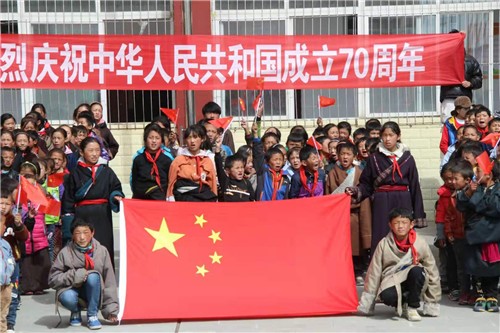
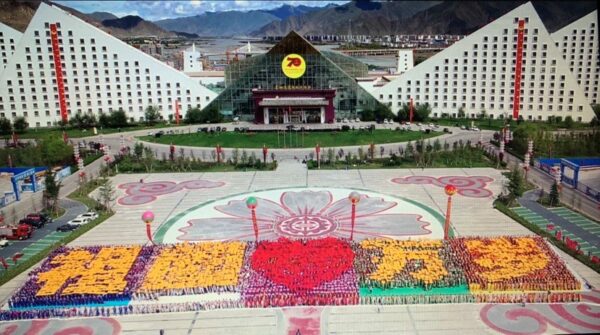
http://www.kangbatv.com/xw/qxxw/2019-09-26/320670.html
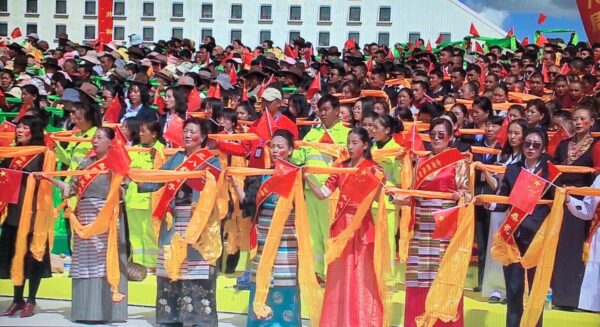
http://www.kangbatv.com/xw/qxxw/2019-09-26/320670.html
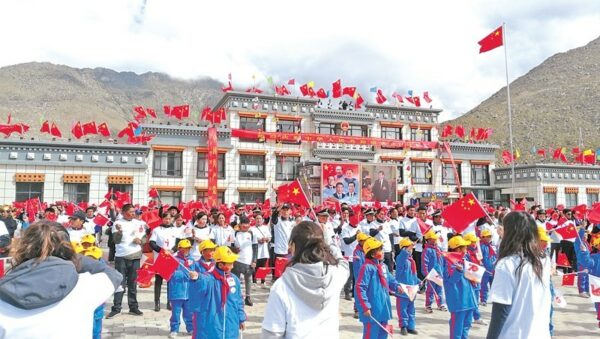
Image from state media report on September 25, 2019 at: http://ali.zgxzqw.gov.cn/xwzx/tp/201909/t20190925_92806.htm
The International Campaign for Tibet (ICT) has previously reported that adjacent to the hotel is the most notorious detention center in Lhasa, with a reputation for brutal torture of Tibetan monks, nuns and laypeople. It serves as a vivid illustration of the co-existence of a security state of total surveillance with mass Chinese tourism in Tibet today.
In Chamdo, a video was broadcast showing ranks of monks spelling out the dates 1949-2019, with monks in sunglasses singing songs of praise to “the motherland.” Reminiscent of 1950s party propaganda, the Chamdo TV item was also evidence of 21st century measures of oppression.
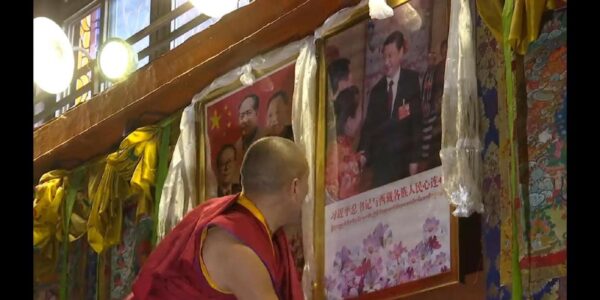
Chamdo, located in the TAR, is of particular strategic importance to the CCP during this anniversary. The Communist authorities gained control of central Tibet when Chamdo fell to the People’s Liberation Army on Oct. 7, 1950. It has been under a heavy crackdown since mass protests in March 2008 led to a dramatic tightening of security in the area and the imposition of “emergency” measures that include a “readiness to defend to the death key sites, key aims, and key areas at sensitive and highly critical periods.” The TV images were in marked contrast to those from last year’s commemoration of National Day in Chamdo, which depicted a handful of monks in a courtyard beside a small red flag.
The same video also showed monks at the Jampa Ling monastery hanging khatags (traditional greeting scarves) on giant images of Xi Jinping and previous Chinese leaders Mao Zedong, Deng Xiaoping, Jiang Zemin and Hu Jintao. In the months preceding the anniversary, Tibetans were required to remove images of the Dalai Lama from their homes and display images of Chinese leaders instead—and in some cases even to prostrate before images of Xi and Mao.
Virtually no place was exempt from official celebration of National Day. In Ngaba (Chinese: Aba) in Sichuan, nomadic children were pictured with red flags, while in Lhokha (Chinese: Shannan) in the TAR, there was a festival for farmers and herdsman for Oct. 1, which authorities described as the anniversary of the “founding of new China.” In Xining, singing, poetry and martial arts performances were arranged to mark the “brilliant achievements of the great motherland, celebrate the new era, the new atmosphere, convey the spirit of the Communists, express the feelings of the Communists, and tells the story of the Communists,” according to a state media report.
Last week, TAR leaders emphasized the increase of securitization in the period around the anniversary, despite the already oppressive measures in place. At a meeting on Sept. 25, Deputy Party Secretary of the TAR Ding Yixian emphasized the need to “fully understand” the “long-term and complex” “anti-separatist struggle.” “Long-term stability” is the political mantra emphasized by China’s leader Xi Jinping and all TAR officials, involving a broad and deep expansion of the powers of military and police backed by grassroots propaganda work and electronic surveillance. Policies relating to security and political control since 2011 are grouped together under the umbrella term “stability maintenance,” which refers to the security measures instituted across the country from 2007 onward to counter unrest and dissent. In Tibet today, even moderate and mild expressions of national identity, religion and culture can be classified as “splittist” and therefore “criminal.”
“Drawing a clear line with the Dalai clique”
The major commemorations of Oct. 1 in Tibet reflect China’s increasingly systematic measures of instilling the “red gene” across Tibetan society, underpinned by efforts to obliterate Tibetan religious and cultural identity. They also show Beijing’s increasing focus on the issue of the Dalai Lama, demonstrated symbolically by the “replacement” of images of the Tibetan leader with giant images of Xi Jinping and other CCP leaders.
Critical to this approach is the training of officially-recognized reincarnate lamas, which now involves tours to “red sites” associated with CCP history, including new “revolutionary” museums and sites associated with Mao, known for the devastation of Tibetan Buddhist monasteries and nunneries following the Chinese takeover of Tibet.
Amid the heightened tension in the buildup to the 70th anniversary, about 150 key religious figures involved in the campaign to erase the Dalai Lama’s influence and “Sinicize” Tibetan Buddhism met in Shigatse (Chinese: Rikaze) in the TAR with the Chinese-installed Panchen Lama and Tibet CCP Chief Wu Yingjie. Although the topic of the meeting was described as “Buddhist Doctrine,” it focused entirely on “adhering to Sinicization” in accordance with the current five-year plan imposed by Beijing to reshape Tibetan Buddhism to comply with CCP objectives.
Officials at the meeting, which was held Sept. 10-11, stressed the need for all Tibetans, not only monks, “to consciously draw a clear line with the 14th Dalai Lama and the Dalai clique and resolutely resist the various activities of the Dalai clique.” This directive represents a further intrusion on the private devotional space of Tibetan Buddhist practitioners, one that would be almost impossible for a monk or nun to reconcile.
Present at the meeting in Shigatse was Drupkhang Thubten Khedrup (rendered in Chinese reports as Trukang Thupden Keldro or Zhukang Tubdankezhub), director of the Tibet Buddhist Theological Institute in Lhasa. Khedrup, a veteran of the TAR People’s Political Consultative Conference, has been a prominent critic of the Dalai Lama; at the height of the wave of Tibetan self-immolations in 2012, he accused the Dalai Lama of inciting these actions, which he stated was “despicable.”
Read ICT’s statement, “Communist China turns 70 but still lacks legitimacy in Tibet.”